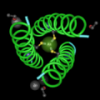How can you win a nerd contest if you don't dress the part?
Last year, I started a shop at CafePress to help distribute lab materials and fund my adventures in science education. Part of the fun has been making molecular merchandise to help show everyone that molecular models are beautiful, in their own special way, and help people engage in random acts of science education.
Here are some of my suggestions for molecular wearables that can help you explain why science is fascinating to people that you meet in the grocery store or the coffee shop.
 Kissing DNA. Unfortunately, the DNA molecules on this shirt are from HIV, but in a pink color they don't look quite so ominous.
Kissing DNA. Unfortunately, the DNA molecules on this shirt are from HIV, but in a pink color they don't look quite so ominous.
 Green fluorescent protein. It's not just for jellyfish! You too can glow with artistic license. Used widely in biotechnology and science education, GFP can also be colorful on a T-shirt.
Green fluorescent protein. It's not just for jellyfish! You too can glow with artistic license. Used widely in biotechnology and science education, GFP can also be colorful on a T-shirt.
 What happens when you mix tobacco smoke and DNA? This last shirt has a more serious message. The image shows shows benzo[a]pyrene, an agent that's produced from tobacco, cross-linked to double-stranded DNA (1). A serious side-effect of smoking, this cross-linked compound blocks DNA replication and contributes to the ability of cigarette smoking to induce lung-cancer.
What happens when you mix tobacco smoke and DNA? This last shirt has a more serious message. The image shows shows benzo[a]pyrene, an agent that's produced from tobacco, cross-linked to double-stranded DNA (1). A serious side-effect of smoking, this cross-linked compound blocks DNA replication and contributes to the ability of cigarette smoking to induce lung-cancer.
That's the problem with learning. Artistic or otherwise, sometimes we learn things we'd rather not know.
References:
1. Gerald W. Hsu, Xuanwei Huang, Natalia P. Luneva, Nicholas E. Geacintov, and Lorena S. Beese. 2005. Structure of a High Fidelity DNA Polymerase Bound to a Benzo[a]pyrene Adduct That Blocks Replication. J. Biol. Chem. 280: 3764 - 3770.
technorati tags: digital biology,
lung cancer, DNA adduct, molecular modeling, Cn3D,
molecular structures
